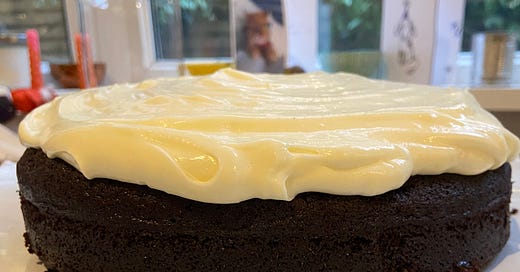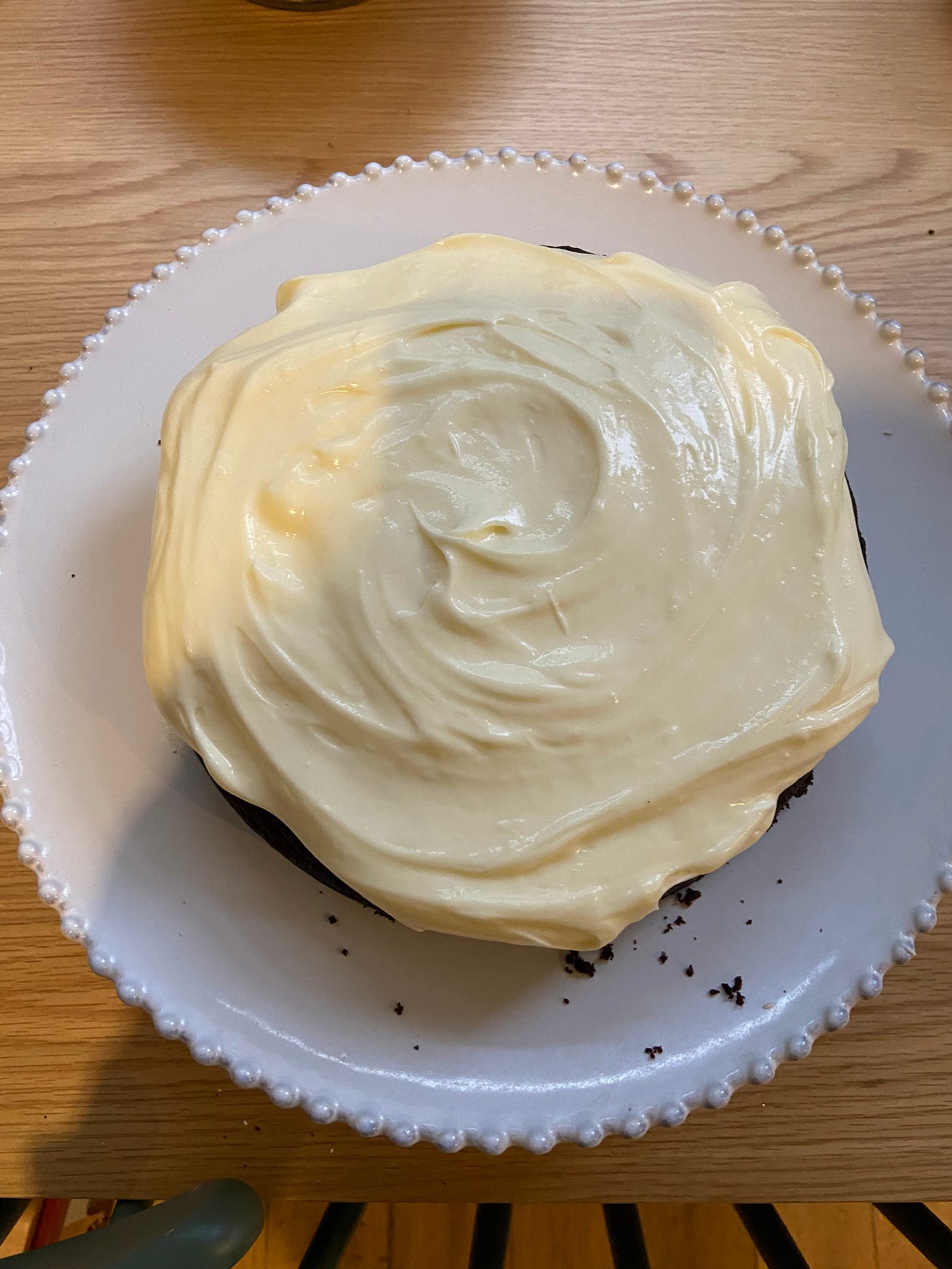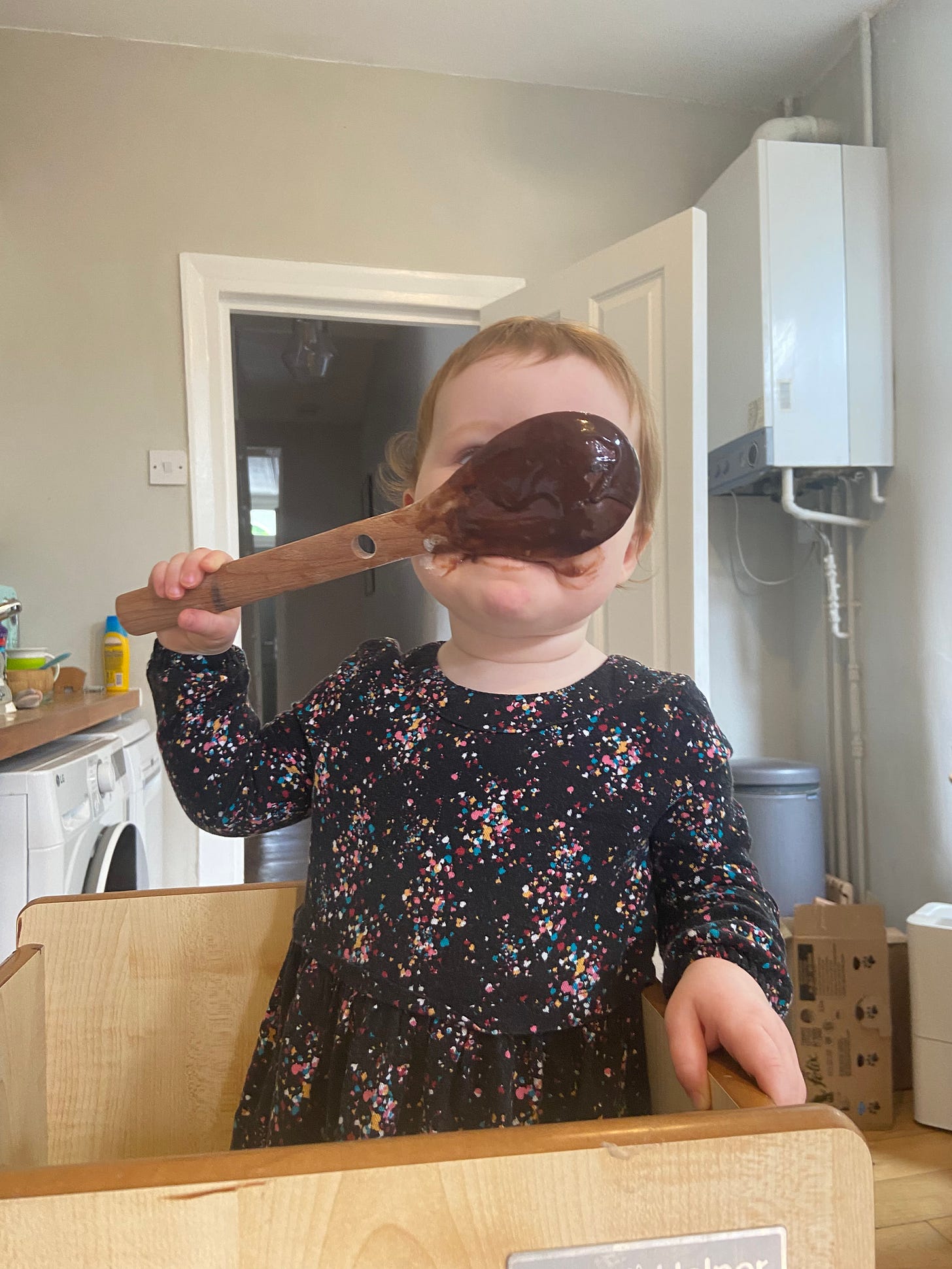I used to have a very high tolerance for looking into the abyss. Now I do not, especially after having a baby. I spent so much time listening to The National and watching The Hours. I thought a lot about scientific concepts like entropy: the way the world tends towards chaos.
I used to find comfort in the fact there was an explanation for all the disorder. But now I must focus instead on the truly remarkable thing: that there is any order in this world at all.
How, for example, can we explain cake? Baking is the antidote to entropy, where things fall apart. In cake, separate things come together.
Yes, the conditions have to be exactly right, and yes, you can’t mess with the recipe or experiment with the baking powder, but it works in opposition to the idea that things are collapsing around us.
This week, I have a desire for the kind of dark cake that is an homage to chaos. Chocolate sponge as leaden as a night with no electricity, something earthy and not overly sweet.
I’ve experimented in the past with a recipe for the Hummingbird Bakery’s Brooklyn Blackout cake, with varying degrees of success.
This recipe reminds me of standing in a gallery in Sydney at a Vanessa Berry exhibition, shortly after my first heartbreak, and reading on a wall: We walked home just as all the streetlights were turning on. I said, ‘look, all the streetlights are turning on, isn’t that special?’ I heard someone in their backyard say, ‘Yes, it is,’ faintly, obviously not to me, but the coincidence was heavenly.
The artist had put out postcards so that you could write her a note. I wrote her lines on one, pocketed it, and kept it in a box for over ten years. Recently, I found it again and pinned it up on my cork board. I still think of it every time I am walking down a street at dusk and the lights turn on.
Something about it always got to me, gets to me still.
I used to think it was because it’s an emblem for loneliness, but now I see that it’s about the magic in things, the possibility of strangers reaching out a hand to you in the darkness.
When I first baked the Brooklyn Blackout cake, I’d never made this kind of icing, a chocolate custard thickened with cornflour and heated on the hob. It was fiddly and sweet, and I wasn’t sure it lived up to its name.
I sat on the floor while I waited for the sponges to bake. I assembled it and my flatmate came home and we ate it together with forks. But I didn’t make the recipe again.
This week, I turn to another inky cake, described by Nigella as ‘magnificent in its damp blackness’.
I almost think a Guinness cake is more of a blackout cake than the actual Brooklyn one: it has a crumby, peaty texture, with a sponge the colour of wet soil.
The icing, although light, is rich and tangy, a necessary foil against too much sweetness.
But I don’t think about any of this, because I make it with P next to me. We’ve recently acquired a toddler tower, which brings her up to the height of the work surface and keeps her safely enclosed, so she can stand next to me in the kitchen.
I give her the vanilla essence to play with (lid tightly closed), a teaspoon and an empty pot of baking powder. She is entertained for a long time simply by placing her items on the counter and then putting them back in the tower with her, on repeat. When her interest in this wanes, she pops up and down like a Jack-in-the-box, squealing as I say: ‘there she is!’
I show her the bowl as I mix, and she takes the wooden spoon and tries to help stir the batter. Even though I have sieved the dry ingredients, it’s lumpy and we don’t have a whisk, so I have to stir and beat with a fork until my arm hurts.
But the process is unctuous and satisfying: melting butter in stout Guinness and marbling it with a mixture of sour cream and eggs.
The icing is meant to replicate the foamy top of the drink and it does the job: a blanket of white made with double cream and cream cheese.
P is easily entertained with her unusual finds at the counter, reminding me of Ariel in The Little Mermaid: ‘Look at this stuff, isn’t it neat!’ Except instead of a mermaid who has no concept of the human world, she is a toddler with no concept of the adult world.
She keeps handing me the vanilla essence and I pretend to keep adding it to the batter, which delights her. Simple pleasures on top of simple pleasures. It feels like cracking some sort of secret code: who cares about the inevitably of chaos when these chubby hands are helping me make a cake?
Now, the abyss isn’t interesting, it’s just scary. For better or worse, I spend my free time trying to look away from it and surround myself with things that give me pleasure.
My dark cake is baked with a round of ‘if you’re happy and you know it’. ‘Appee!’ she says.
She has no concept of entropy. And, let’s be real, neither do I. It was easy to once write that entropy explains the likelihood of disorder and that in the face of that, life is extraordinary. That we were ever formed, that it ever happened.
But what did I know, what do I know, of the fact that time is going one way and we are going with it? Even when I’ve seen it (see it!) happen? The world will fall apart because it’s just overwhelmingly more likely to do so.
So?
The cake is done and I have to wait for it to cool before icing it. The icing turns out lumpy too, so when she’s in bed I try to quietly use the electric whisk to smooth it out. It’s perfect, exactly as it should be.
It’s a happy cake, a happy day that cares nothing of the idea that one day the world will be one endless night.
Instead, a spoon is licked, batter pressed to a toddler’s nose: a sweet revelation that out of the darkness there is light.








Gorgeous story. I love a rich, dark chocolate cake. My favourite is a one pan mocha cake (with accompanying coffee brittle) by Australian cookbook author Belinda Jeffrey.